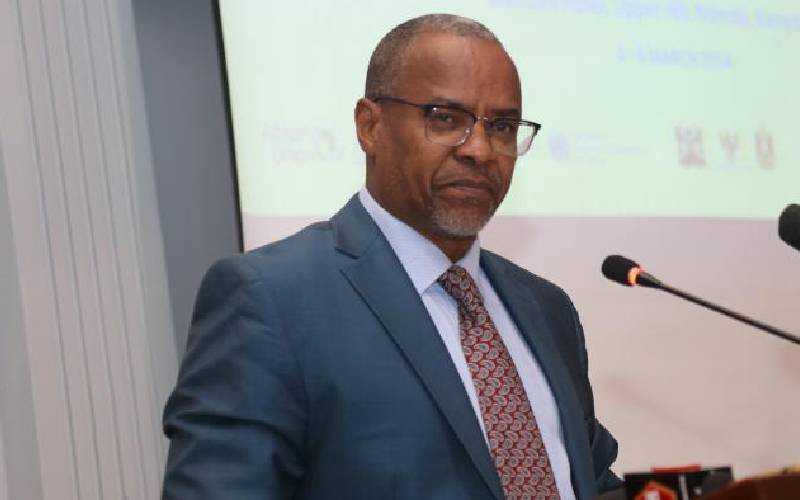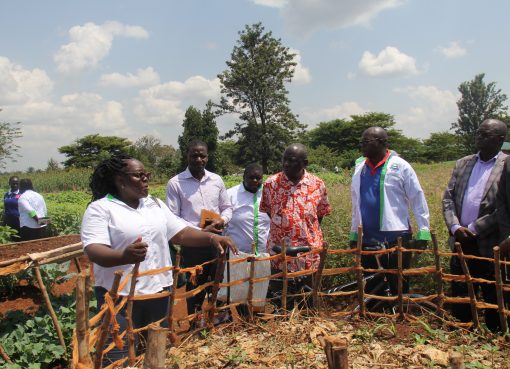The Government has lined up several projects running into billions of shillings to ensure a stable supply of water in the country and achieve the country’s vision of universal access to water and sanitation by 2030.
Water, Sanitation and Irrigation Cabinet Secretary Zachariah Mwangi Njeru said the Kenya Kwanza pledged to provide clean safe water to Kenyans at their doorstep by 2030 and will push to ensure that this was achieved.
“My ministry will remain focused to realise the ultimate goal by President William Ruto to ensure in the next six years the provision of water and sanitation services for all Kenyans is achieved as part of the bottom-up economic transformation agenda in the country,” said Njeru, adding that the move will also guarantee water availability for irrigation.
Speaking in Nakuru during a public engagement on the Medium-Term Plan Four (MTPIV) 2023-2027 at Waterbuck hotel, the Cabinet Secretary indicated that to fulfil the Kenya Kwanza campaign pledge, the State will construct 100 large dams, 1000 medium dams and over 4000 dams and water pans.
He said President Ruto’s pledge was also in line with the Constitution which says that it is the right of every Kenyan to have access to clean safe water by 2030.
The CS pointed out that since Kenya had made a commitment under United Nations Agenda 2030 on sustainable development, the government will ensure proper management of water and sanitation for every Kenyan.
“This is reflected in Kenya’s Constitution on the right to a reasonable standard of living section 43 (economics and social rights) which guarantees all citizens to rights to access clean and safe water and affordable sanitation,” said Mr Njeru.
The CS said to realize this dream, those in the water sector must be proactive and become innovative in the use of technology to make every Kenyan have access to water.
He told water providers to come up with better ideas on how to manage water supply so that there was no wastage as was the case in various counties.
In November last year the Cabinet approved rehabilitation of more than 4,000 water pans in the new plan that seeks to ensure a stable water supply.
The plan which will cost Sh83 billion includes the construction of 25 medium-sized dams serving mainly arid regions.
The dams are expected to supply a cumulative total of 353 million litres, serving more than 600,000 households.
The government has also announced plans to implement the Sh21 billion Thika and Githunguri Water and Sanitation Project in Kiambu County.
The project, to be completed in the next three years, is expected to increase water supply for 1.2 million people in Thika and Githunguri towns and the semi-arid Ithanga area of the neighbouring Murang’a County.
Financed by the Government of Kenya and Danida Sustainable Infrastructure Finance (DSIF), the project is being implemented by the Athi Water Works Development Agency (AWWDA).
Busia county has received Sh300 million from the national government for completion of the multi-million Malaba-Malakisi water project.
The project funded through Lake Victoria Water Works Development Agency is expected to benefit at least 180,000 households.
In Murang’a, the Athi Water Works Development Agency (AWWDA) is constructing phase II of the Northern Collector tunnel at a cost of Sh12 billion while Maragwa 4 dam is estimated to cost Sh35 billion.
In neighbouring Kiambu, five dams have been lined up for construction in order to meet the county’s pressing water demand. The dams are Ndarugu II, Kamiti, Thiririka, Ruiru II and Gatamaiyu whose estimated cost is Sh73 billion.
In a further bid to quench thirsty residents of Thika and Githunguri, the government has announced plans to implement a Sh21 billion water and sanitation project in Kiambu county. The project involves construction of Thika 3A dam at the confluence of River Thika and Kiama which will hold 14.6 billion litres of water
The Ministry has also launched a six-year project to improve groundwater availability and management in the Horn of Africa borderlands.
The project, dubbed the Horn of Africa Groundwater for Resilience Program (HOAGW4RP), will benefit the counties of Turkana, Marsabit, Mandera, Wajir, and Garissa, which are prone to drought and water scarcity.
The project aims to increase sustainable access to and management of groundwater by drilling and rehabilitating 400 boreholes, providing strategies and policies to protect groundwater resources, and building the capacity of water service providers and users
Addressing the forum Environment, Climate Change and Forestry Principal Secretary Engineer Festus Ngeno, said Kenya has upped her national commitment, to reducing greenhouse gas emissions in her strategy to cope with the global warming phenomenon.
Eng Ngeno said measures set out by the country to address climate action included an undertaking to conserve and restore 10.6 million hectares of degraded landscapes and ecosystems, through planting and nurturing 15 billion trees by 2032.
The Principal Secretary said efforts to tackle climate action calls for an “all hands on the deck” approach that encompasses the participation of government entities at the national and county level, as well as private sector actors and the entire citizenry.
He noted that addressing climate action is a costly affair, adding that the challenge of inadequate financial resources has been a hindrance for Kenya and other developing countries in effectively mounting climate change mitigation and adaptation initiatives.
Eng Ngeno said to address the challenge posed by inadequate resources, the Government has with support from development partners initiated a programme on Financing Locally Led Climate Action (FLLoCA), to deliver locally led climate resilience actions and strengthen both the National and County governments’ capacity to manage climate risks.
PS Ngeno reiterated the need for a whole of government approach to combat the adverse effects of climate change that have wreaked havoc on all sectors of the economy, resulting in a five percent loss in GDP annually.
“I am sure that all of you here must have been affected either directly or indirectly by climate change impacts in the last one year. We all witnessed the devastating droughts and floods that happened in the last one year,” Eng. Ngeno noted.
He said excess rains arising from climate change has spawned new strains of diseases in areas where they were previously unheard of and cited new malaria fevers reported in Marsabit and Wajir counties.
Eng Ngeno reiterated the commitment by the State Department for Environment and Climate Change, to drive collective efforts to address the global challenge of climate change by various actors in the country.
He observed that encroachment for agricultural activities, pollution, urbanisation and climate change among others were the main threats to Kenya’s wetlands. This he added has consequently led to loss of key wetlands and associated products and services.
Wetlands are waterlogged areas, which can include marshes, swamps and bogs. They are critical habitats for countless plant and animal species.
According to the PS, wetlands act as natural sponges, absorbing and filtering excess nutrients, pollutants and sediments from water bodies, which help to purify water and prevent flooding.
Furthermore, wetlands are essential for biodiversity conservation. They provide critical habitat for migratory birds, fish and other wildlife.
Wetlands are also important carbon sinks, with the ability to store large amounts of carbon in their soils and vegetation.
He stated that by conserving and restoring wetlands, the country can help to reduce greenhouse gas emissions and combat climate change.
While indicating that the State had banned grazing animals in forests, he asked people who had encroached wetlands and were making bricks, washing vehicles and draining-off Wetlands, for farming activities to stop forthwith.
Principal Secretary, State Department for Lands and Physical Planning Nixon Korir said that county physical planners should seek to balance demands for development with the need to protect the environment while achieving the devolved units’ social and economic objectives.

He said the State was decentralizing land registries to Sub-County levels noting that new registries had been set up in Molo and Gilgil Sub-Counties to supplement the ones in Nakuru Town and Naivasha.
Mr Korir stated that they were digitizing land services to enhance efficiency, cut on bureaucracy and eliminate corrupt practices.
Governor Susan Kihika in a speech read on her behalf by Deputy Governor David Kones stated that the Sh 117 billion County Integrated Development Plan (CIDP) is largely focused on achieving industrialisation by transforming the region’s economic structure of subsistence farming to agricultural-led industrialisation.
Governor Kihika indicated that the CIDP 2023-2027 would also guide her economic development agenda for the next five years.
The 3rd generation CIDP is in line with the constitutional requirement that no government resources should be appropriated outside a planning framework.
She said the document had been subjected to scrutiny by various stakeholders, including the public, and the County Assembly.
Guided by the CIDP, Ms Kihika pledged that her administration would promote sustainable agricultural practices, support smallholder farmers, and create value-addition opportunities to ensure food security and boost the agro-based economy.
In the infrastructure sector, the County boss indicated that priority would be made on the expansion and maintenance of road networks through the Imarisha Barabara programme, and the enhancement of digital superhighway in the County.
“Grading and gravelling of 2000 kilometres of earth road through the Imarisha Barabara programme and tarmacking 66 kilometres of roads within urban centres are among the plans contained in the document,” Kihika said.
She said her administration would explore the use of solar energy to power 80 percent of street lights under the County Street Lighting master plan programme.
The Governor added, “The County will further seek to improve the healthcare facilities to enhance access to quality and affordable healthcare services. The County Government is committed to invest in quality education and skills development initiatives in order to improve the transition rate in Early Childhood Development Education and graduation rate in Vocational Training Centres.”
By Anne Mwale




